
EV Battery Production Testing – A New World of Challenges
Electric vehicle battery cell, module, and pack production systems rely on precision electrical instruments to reliably identify variation. Manufacturers depend on affordable test equipment to:
- Consistently detect tiny electrical anomalies
- Integrate into complex and diverse automated systems
- Adapt as testing requirements evolve
- Deliver zero downtime
Test engineers are working closely with R&D engineers to bring new battery technologies to reality. And engineers trust Keithley precision measurement instruments to help them to push the boundaries.
EV Battery Technology and Critical Production Tests
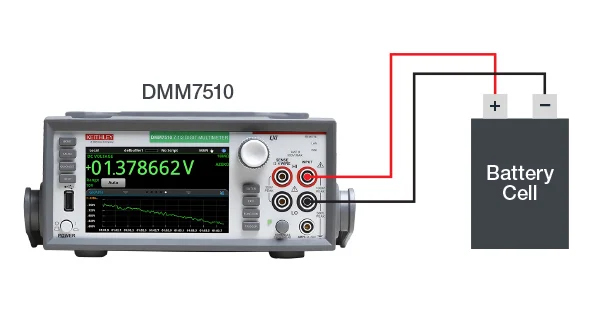 Battery Grading with Open Circuit Voltage
Battery Grading with Open Circuit Voltage
Testing (OCV)
Battery grading is a critical step in any battery production environment where
battery performance is key. Open circuit voltage (OCV) measurements
are used to bin the batteries into the following grades:
-Grade A batteries have the longest lifespans, lower internal impedance and better overall performance. Used in high power applications like electric vehicles.
-Grade B batteries have lesser performance and shorter lifespans. Used for energy storage applications
-Grade C batteries are the lowest performing. Used for single cell portable applications
Manufacturers need to separate the highest quality batteries from the batteries that may
have internal defects such as microshorts or contaminants. The OCV of the battery can
be monitored over time to observe discharge trends and characterize performance. This
process can take weeks to observe changes in the OCV in tens to hundreds of microvolts.
Keithley’s DMM7510 is a perfect solution for OCV testing in the production environment.
Its 7.5 digit measurement resolution and superior accuracy means measuring smaller changes in
voltage and getting results sooner. For higher volume applications, the Keithley 3706A System
Switch and Multimeter allows for up to 576 two-wire channels in one mainframe, expanding
your testing capabilities without sacrificing test rack or bench space.

Battery Tab and Busbar Weld Checking
with Resistance Measurements
Welding is common practice in automated production systems to connect the cell
tabs to the electrodes as well as connecting completed cells together to form a battery
pack. Large battery packs can have tens to hundreds of welds, or joints, connecting
cells to busbars.
A good quality weld joint contributes little resistance to the circuit, typically only
microohms. Bad welds or joints can measure in the milliohm range which leads
to performance issues and excess heat generation that can cause a severe
thermal runaway event. It is nearly impossible to visually identify a bad weld.
However, weld imperfections can be quickly identified in a production environment
with a resistance measurement using a precision DMM such as the Keithley 3706A
System Switch and Multimeter and a current source such as a Keithley 2460 SMU.
The SMU can provide precision current up to 7 A while the DMM measures the resistance
of the joint down to microohms. The high density built in switching in the 3706A enables
more weld checks with less rewiring.
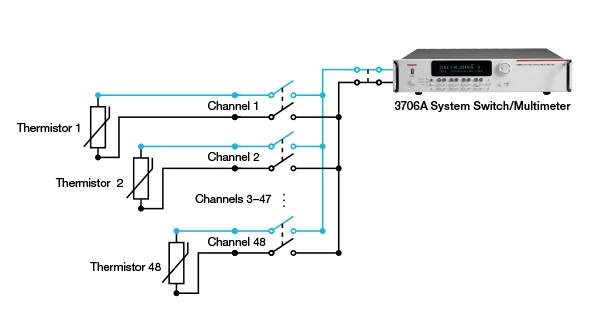 Environmental and Safety Testing using
Environmental and Safety Testing using
Temperature Datalogging
Environmental testing is extremely important to ensure batteries will withstand and perform under extreme environmental conditions. Thermal testing is also an important part of safety qualifications. Although temperature testing varies widely depending on the test sequence, battery type, and physical constraints, common temperature measurements on a battery
include:
-Internal temperature of a cell or module using an embedded sensor
-External temperature of a cell or module
-Monitoring the ambient temperature around the pack to understand
heat dissipation or to verify the environmental conditions.
Because battery performance is temperature dependent, engineers measure, document,
and in some cases characterize and program the batteries into the EV when installed.
Temperature is also an indicator of cell failure and thermal runaway.
The Keithley 3706A System Switch and Multimeter is a high density switching system
with up to 576 2-wire channels per mainframe. The customizable switching configuration
can be configured for density for more monitoring points or for speed for quick
temperature checks.
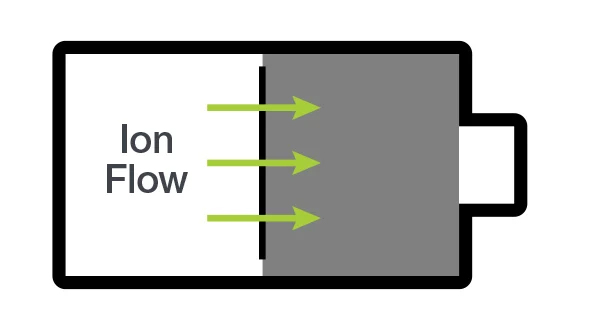 Quantifying Battery Self-Discharge with
Quantifying Battery Self-Discharge with
Open Circuit Voltage Testing (OCV)
Batteries tend to discharge over time when they are not connected, as the chemical reaction slowly reverses itself internally. Ideally, this internal self-discharging current is extremely small so the battery can hold a charge longer. Batteries with internal defects such as microshorts, pinholes in the separator and contaminants, discharge faster over time than their higher quality counterparts.
This could cause poor performance and balancing issues in a pack or cause the
cell to be stressed. The open circuit voltage (OCV) of the battery can be used to
monitor the self-discharge behavior as the open circuit voltage decreases when
the battery discharges. Separating the good batteries from the defective
batteries before they are placed in a pack can require weeks of monitoring as OCV
changes may only be tens to hundreds of microvolts.
Keithley’s DMM7510 is a perfect solution for OCV monitoring to measure self-discharge. The 7.5 digit
resolution and superior accuracy means measuring smaller changes in voltage and viewing trends sooner.
For higher volume applications, the Keithley 3706A System Switch and Multimeter allows for up to 576
two-wire channels in one mainframe, expanding your testing capabilities without sacrificing test rack or
bench space.
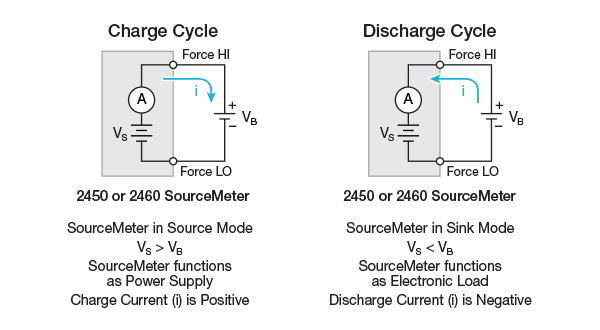 Formation, Aging and Battery Cycling
Formation, Aging and Battery Cycling
The most important part in the battery cell manufacturing process is the formation and aging stage, where critical chemistry mechanisms are established in the battery. The results of this process directly affect the battery’s performance later in life and post-formation testing is conducted to identify batteries that failed to form correctly.
Formation and aging require the battery to be repeatedly charged and discharged at varying rates. Cycling the batteries is a crucial component in many other tests, including modeling and thermal characterization.
Test procedures vary widely depending on battery chemistry, construction and
the test profiles. And many other tests require the batteries to be cycled,
so test solutions must be flexible.
Keithley source measure units or SMUs provide a convenient single box solution for charging and discharging.
The 2400 Series Graphical Touchscreen SMUs can accurately source currents up to 7 A DC.
These SMUs offer TSP® Scripting Technology to make production automation simple and efficient.
 Ensuring Battery Quality with DC
Ensuring Battery Quality with DC
Internal Resistance
Batteries with high internal resistance have lower performance and higher risk of failures like thermal runaway. Internal resistance is an indicator of an incorrectly formed solid electrolyte interphase (SEI) layer and may also be used as a metric for battery quality.
Keithley source measure units (SMUs) provide a single box solution for DC internal resistance testing. The 2400 Series Graphical Touchscreen SMUs can source an accurate low current and measure the corresponding voltage to calculate the internal resistance.
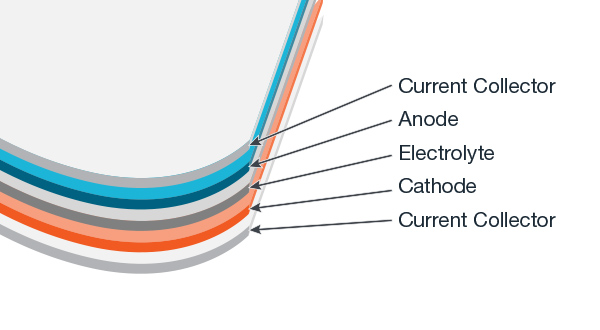 Check Electrode Contact Quality with
Check Electrode Contact Quality with
Low Resistance Measurements
Poor connection between the current collector and the electrode material that is rolled onto the collector increases the internal resistance of the battery. Identifying poor electrodes early on saves time and resources later in the manufacturing process.
The Keithley 6200 Series Sensitive Current Sources paired with the 2182A Nanovoltmeter makes the perfect combination for sensitive low resistance measurements on electrodes. This low resistance combination measures as low
as tens of nano-ohms for the best confidence in the quality of the electrode.
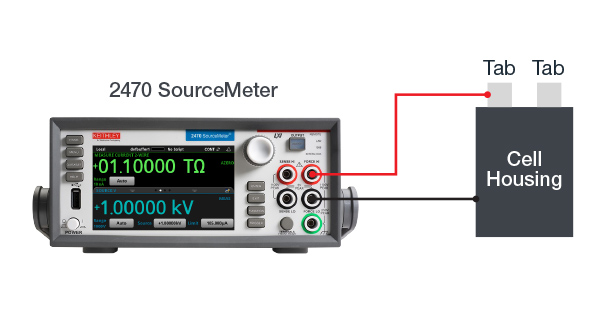 Keep Batteries Isolated by Measuring
Keep Batteries Isolated by Measuring
Insulation Resistance
Shorted batteries means risk of dangerous failures. Shorts can occur internally, but there
is also risk of external shorts when insulation fails, or a battery is incorrectly connected to the pack. Verifying the isolation of the cell electrodes from ground and the insulation quality of any materials exposed to current can prevent a serious failure later.
The Keithley 2470 High Voltage Source Measure Unit (SMU) provides a simple, single-box solution to measure the resistance of materials. The SMU can source voltage up to 1 kV and calculate the corresponding resistance of the material.

 KALİBRASYON LABORATUVARI
KALİBRASYON LABORATUVARI
 Battery Grading with Open Circuit Voltage
Battery Grading with Open Circuit Voltage
 Environmental and Safety Testing using
Environmental and Safety Testing using Quantifying Battery Self-Discharge with
Quantifying Battery Self-Discharge with Formation, Aging and Battery Cycling
Formation, Aging and Battery Cycling Ensuring Battery Quality with DC
Ensuring Battery Quality with DC Check Electrode Contact Quality with
Check Electrode Contact Quality with Keep Batteries Isolated by Measuring
Keep Batteries Isolated by Measuring